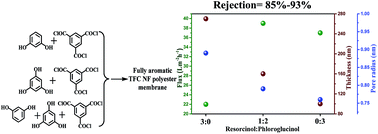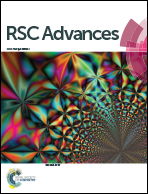The effect of phenol functionality on the characteristic features and performance of fully aromatic polyester thin film composite nanofiltration membranes†
Abstract
Fully aromatic polyester thin film composite (TFC) nanofiltration (NF) membranes were successfully prepared on polysulfone support through interfacial polymerization (IP) of trimesoyl chloride (TMC) with bi-functional resorcinol (Res), tri-functional phloroglucinol (Phg) and their mixtures. The functionality of phenol greatly influenced the properties and performances of the membranes. Most notably, the active layer thickness (estimated from cross-sectional SEM images) and pore radius (from Hagen–Poiseuille pore flow model) decreased with an increasing amount of Phg. The best salt rejection and permeate flux were obtained with the membranes prepared from 2 : 1 (w/w) Phg : Res (TFC5) or pure Phg (TFC6). The membranes were negatively charged under operating pH conditions, as a result of which divalent anions were efficiently rejected whereas divalent cation rejection was considerably lower. TFC5 and TFC6 membranes showed promise for arsenic removal, giving 70–90% rejection of Na2HAsO4 depending on the ionic strength and pH of the feed water.


 Please wait while we load your content...
Please wait while we load your content...